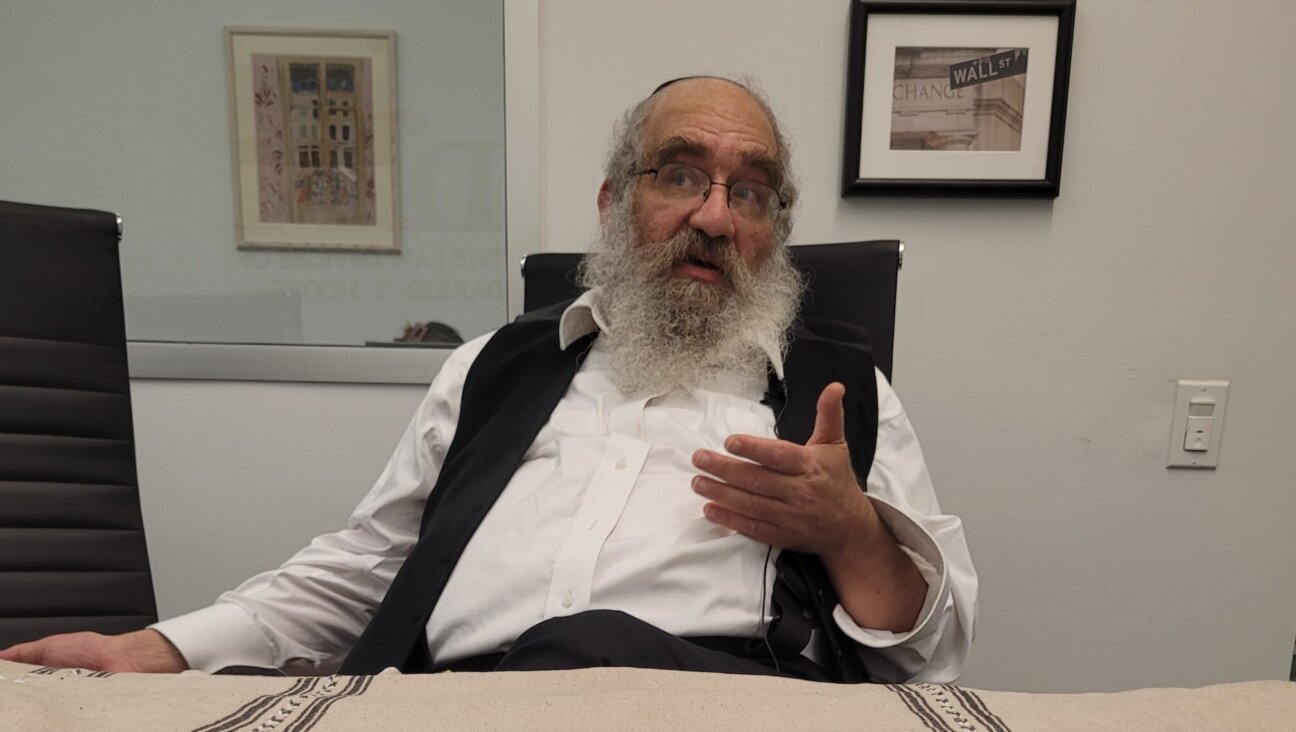Deconstructing Cholent

Comfort Food: Women in Bialystok carry pots of cholent to the baker?s oven on a Friday afternoon. This image first appeared in the Forverts on November 20, 1932. Image by FORWARD ASSOCIATION
The first time I came face to face — or rather, spoon to mouth — with a bowl of cholent, at the age of 24, I had no idea what it was. While I was growing up in a nonobservant home, my family had no need for such a meal, a hearty stew that simmers overnight in a pre-lit oven or slow cooker without transgressing the prohibition against cooking on the Sabbath. But as I learned (and tasted) more, I discovered a dish that can wrap even the coldest late-winter afternoon in warmth and comfort, and one that makes a valuable addition to any Jewish cook’s repertoire.
The custom of honoring the Sabbath with a hot meal is revered in Jewish tradition, but the Torah complicates things by stating, “You shall kindle no fire throughout your habitations upon the sabbath day” (Exodus 35:3). As early as the fourth century, Jewish cooks began to perform culinary acrobatics to circumvent this halachic conundrum — finding ways to get hot food on the table without lighting a new fire. Renowned cookbook author Joan Nathan wrote in her book “Jewish Cooking in America”:
“For centuries, on Friday mornings [Jews] would assemble [their stews]. The dish was covered with a cloth or mixture of flour and water to form a crust. It started cooking on Friday before sunset and [was] left to warm all night over coals in a hot oven….”
In many communities, long before the Crock-Pot came on the scene, Jewish women brought their cholent pots to the local baker, where they sat in the hearth (still hot from Friday morning’s challah) until lunchtime the following day. According to “The Jews of Poland,” the 1929 anthropological account of French scientist and food writer Edouard De Pomiane, cholent actually once referred to the style of cooking rather than to the food itself. De Pomiane wrote: “Everything prepared in this way is given the name cholent. A beef stew, cooked in this way, would become a cholent stew; beans become cholent-beans.” De Pomiane’s book also includes a recipe for “cholent coffee,” which brewed in the baker’s oven, alongside the stews.
It’s this creativity, born of need, that distinguishes Jewish cooking in general, and cholent in particular, from other cuisines. People of most other cultures would not have conceived of a dish such as cholent, because, like my family, they are free to cook seven days a week. Perhaps that is why some scholars identify cholent as one of the few authentically “Jewish” recipes in a food repertoire known for adapting to and borrowing from the many different countries in which Jews have lived throughout history. Rabbi and food historian Gil Marks wrote in his book “The World of Jewish Cooking,” that cholent was actually a precursor to the traditional American dish Boston baked beans. The Pilgrims picked up the idea for cholent from Sephardic Jews in Holland, where they stopped for several years before voyaging across the Atlantic. “In America,” Marks wrote, “the Pilgrims substituted maple syrup and bacon for the traditional molasses/honey and goose fat….”
Today, cholent (also called dafina, hamin or schalet, depending on its Sephardic or Ashkenazic origins) comes in several forms. It is generally made either savory with beans, beef and barley, or sweetened with yams, cinnamon and molasses. Some recipes (mostly Ashkenazic) include kishke, a sausagelike casing, stuffed with meat and grains, that cooks inside the stew. Others (generally Sephardic) call for unpeeled eggs, which turn a beautiful sepia brown as they boil.
Individual cooks personalize their cholent recipe even further, tweaking it and improvising on it to suit their palates. Author Nathan told me that “cholent changes depending on the locale and the customs. In America it is Americanized, and in other countries, like France, it is French-ified. We all add our ingredients that make it ours.”
My personal taste for cholent, which I’ve honed over the past couple of years, since that first fateful bite, eschews the beef in favor of a vegetarian, beans-only version. In that sense, cholent’s many iterations reflect the myriad and diverse communities of the Jewish Diaspora itself. What binds these recipes together is their long, slow simmer in a covered pot, and the cook’s anticipation of a hearty meal.
Not surprisingly, cholent has solidified its place in the Jewish food canon — both on and beyond the Sabbath table. The Queens, N.Y.-based ice cream store Max & Mina’s even features a cholent-flavored ice cream (which, like mine, is meat-free). As Nathan said, “To me, dishes like cholent make writing about Jewish food so worthwhile.” My husband — not a professional food writer, but a lifelong cholent eater — reverently tells the story of a Sabbath he spent in Allentown, Pa., where the local synagogue hosted a cholent cook-off. More than 10 families hauled their slow cookers to the synagogue Friday afternoon, and after services the next day, congregants shuffled around the Kiddush hall, tasting each stew and dropping a slip of paper in a box next to their favorite. After 15 minutes, his appetite was ruined. But after a nosh like that, who needs lunch?
Leah Koenig is a writer whose work has appeared in the New York Times Magazine, Gastronomica and other publications. She lives in New York City.
Vegetarian Cholent
Leah Koenig’s recipe, originally published on The Jew & the Carrot (www.jcarrot.org), serves 6-8
2 tablespoons olive oil
1 large onion, cut into medium dice
3-4 garlic cloves, minced
½ teaspoon tarragon *
*½ cup vegetable broth
2 bay leaves
1 cup peeled and sliced carrots (about ½-inch thick) *
*2 medium potatoes, peeled and cut into ½-inch chunks *
*2 medium sweet potatoes, peeled and cut into ½-inch chunks
1 (15-ounce) can vegetarian baked beans, including juice
3 cups water
1 cup dark beer, such as porter or stout
½ cup seitan chunks
½ cup bulgur
1 cup green peas (if you use canned, drain them well; if frozen, thaw and drain)
1 teaspoon salt
Black pepper to taste
1) The evening before you plan to eat the dish, preheat a large soup pot over medium heat. Sauté the onions in the oil until translucent, 5 to 7 minutes.
2) Add the garlic, tarragon, salt and pepper. Sauté until the garlic is fragrant, about a minute more.
3) Deglaze the pot with the vegetable broth. Pour the deglazed mixture into a large crockpot and add the bay leaves, carrots, potatoes, sweet potatoes, baked beans, water, beer, seitan, bulgur and peas.
4) Set the Crock-Pot on low and let it cook away until lunch the next day.
Meat Cholent
The following recipe is published with permission from “The World of Jewish Cooking” (Simon & Schuster), by Gil Marks, serves 6-8
10 to 14 oz (1 1/2 to 2 cups) any combination dried navy, lima, pink or kidney beans
1 1/2 pounds beef or veal marrow bones
3 medium yellow onions, sliced
2 to 3 garlic cloves, minced
6 to 8 medium potatoes (2 to 2 1/2 pounds), peeled and quartered
2 to 3 pounds beef short ribs, brisket, or chuck roast, cut into 2-inch cubes
3/4 cup pearl barley
About 2 1/2 teaspoons salt
About 1/2 teaspoon ground black pepper
1) Soak the beans in water to cover overnight. Drain.
2) In the order given, place the bones, beans, onions, garlic, potatoes, beef, and barley in a 6- to- 8-quart pot. Add enough water to cover.
3) Bring to a boil, cover, reduce the heat to medium-low and simmer, skimming the foam from the surface, until the beans are nearly soft, about 1 hour.
4) Season with salt and pepper. (Salt prevents the beans from softening properly and therefore is added after the beans are tender.) Tightly cover, place on a blech (a thin sheet of metal placed over the stove top) over low heat or in a 225-degree oven, and cook overnight.
Cholent can also be cooked on the stove for 1 hour as in step 3, then transferred to a Crock-Pot set on low to cook overnight.
















